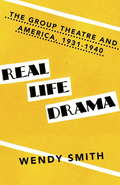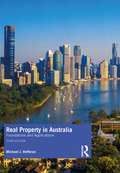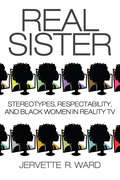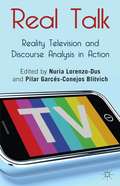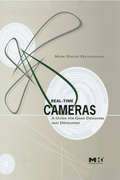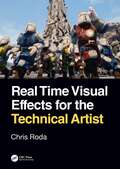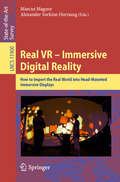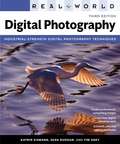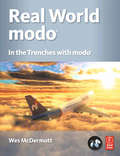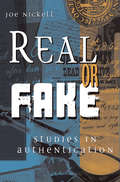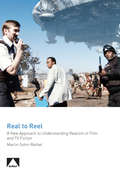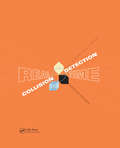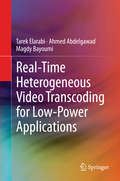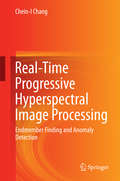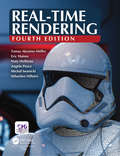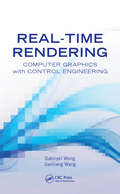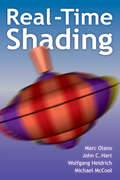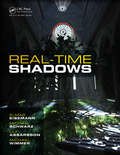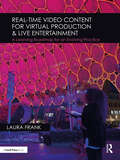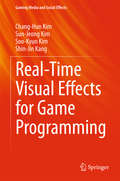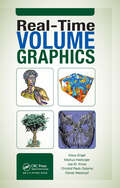- Table View
- List View
Real Life Decor: 100 Easy DIY Projects to Brighten Your Home on a Budget
by Jean NayarThe economy may have stalled but life goes on. Chair legs break, pillows lose their puff, painted walls get scuffed and sheets get torn or go out of style. Real Life Decor brims with ideas for repurposing, reusing or replacing your accents and furniture to keep your home fresh and functional as well as wallet-friendly. Comprised of a collection of 100 easy, appealing projects illustrated with lively photos and simple how-tos, the book is divided into 7 sections that offer multiple approaches to dressing up walls, sewing simple soft furnishings, recycling old furniture, brightening lamps and accents, making multipurpose furnishings and storage, and sprucing up floors and ceilings. The photos include inspiring ideas that the reader can interpret and emulate as well as pretty projects they craft to the T. Sidebars with simple solutions on topics such as Displaying Your Collections, Easy Vintage Fabric Ideas, and Small Space Ideas enrich each chapter with additional tips.
Real Life Drama
by Wendy SmithReal Life Drama is the classic history of the remarkable group that revitalized American theater in the 1930s by engaging urgent social and moral issues that still resonate today. Born in the turbulent decade of the Depression, the Group Theatre revolutionized American arts. Wendy Smith's dramatic narrative brings the influential troupe and its founders to life once again, capturing their joys and pains, their triumphs and defeats. Filled with fresh insights into the towering personalities of Harold Clurman, Lee Strasberg, Cheryl Crawford, Elia Kazan, Clifford Odets, Stella and Luther Adler, Karl Malden, and Lee J. Cobb, among many others, Real Life Drama chronicles a passionate community of idealists as they opened a new frontier in theater.
Real Property in Australia: Foundations and Applications
by Michael J. HefferanReal property in the form of investment, ownership and use pervades almost every aspect of daily lives and represents over 40% of Australia’s wealth. Such assets do not exist in isolation – they are dynamic and forever evolving, impacted by a range of physical, economic, demographic, legal and other forces. Consequently, a true appreciation of individual assets and of the property sector as a whole demands an understanding of both the assets themselves and the context and markets in which they exist. The sector is complex and, on the face of it, confusing. It is however, not without logic and underlying themes and principles. This book provides a wider understanding of how the real property sector works. It covers topics such as the nature of real property and its functions, economic drivers, valuation principles, legal and tenure parameters, property taxation, land development and subdivision, asset and property management and sustainability – all critical components in this complex and critically important sector. It provides a wide and balanced perspective for experienced practitioners, investors, students and anyone involved in property decision-making or wishing to secure a deeper understanding of these areas. The book integrates research-based theory with practical application and first-hand insights into a sector that underpins the Australian economy, its communities and its sustainability.
Real Retouching: The Professional Step-by-Step Guide
by Carrie BeeneFrom the perfect glossy pages of a magazine to the larger-than-life images floating on a billboard in the sky, image retouching has become a key component of today's digital photography world. So popular, in fact, that the sheer act of retouching has become its own verb as we often ask ourselves, "I wonder if this image was Photoshopped?" Sometimes controversial but widely accepted, and even expected, excellent retouching skills are crucial to finding success in the field of digital imaging. As you work through the clear step-by-step instructions in the book using the images provided on the bonus CD, you'll learn how to do real retouching jobs from start to finish, including each and every technical step along the way. You'll also get behind the scenes advice for talking to clients and establishing a workflow to ensure that your client gets the results they are looking for. If you're a student or aspiring professional just starting out in the world of retouching, the information found in this book can help you find work in the advertising/retouching industry. If you're already a working photographer, you'll be able to add retouching to your repertoire as an additional offering to your clients. Carrie Beene is a professional retoucher and educator who has worked with some of the world's most prestigious companies, including Revlon, MAC, and L'Oreal, and has contributed imagery to such renowned publications as the New York Times, Sports Illustrated, and Vanity Fair. In this excellent new book, she'll share the techniques she has learned and developed over the years to help you navigate the often mysterious world of image retouching.
Real Simple Organize Your Home
by The Editors of Real SimpleThe editors of Real Simple Magazine present Organize Your Home.
Real Sister
by Cynthia Davis Detris Honora Adelabu Latoya Jefferson-James Terry A. Nelson Alison D. Ligon Sheena Harris Preselfannie E. Whitfield McDaniels Monica Flippin Wynn Jervette R. Ward Sharon Lynette JonesFrom The Real Housewives of Atlanta to Flavor of Love, reality shows with predominantly black casts have often been criticized for their negative representation of African American women as loud, angry, and violent. Yet even as these programs appear to be rehashing old stereotypes of black women, the critiques of them are arguably problematic in their own way, as the notion of "respectability" has historically been used to police black women's behaviors. The first book of scholarship devoted to the issue of how black women are depicted on reality television, Real Sister offers an even-handed consideration of the genre. The book's ten contributors--black female scholars from a variety of disciplines--provide a wide range of perspectives, while considering everything from Basketball Wives to Say Yes to the Dress. As regular viewers of reality television, these scholars are able to note ways in which the genre presents positive images of black womanhood, even as they catalog a litany of stereotypes about race, class, and gender that it tends to reinforce. Rather than simply dismissing reality television as "trash," this collection takes the genre seriously, as an important touchstone in ongoing cultural debates about what constitutes "trashiness" and "respectability." Written in an accessible style that will appeal to reality TV fans both inside and outside of academia, Real Sister thus seeks to inspire a more nuanced, thoughtful conversation about the genre's representations and their effects on the black community.
Real Talk: Reality Television and Discourse Analysis in Action
by Nuria Lorenzo-Dus Pilar Garcés-Conejos BlitvichThis is the first book to examine the discourse of reality television. Chapters provide rigorous case studies of the discourse practices that characterise a wide range of generic and linguistic/cultural contexts, including dating shows in China and Spain, docudramas in Argentina and New Zealand, and talent shows in the UK and USA.
Real Time Cameras: A Guide for Game Designers and Developers
by Mark Haigh-HutchinsonThe control of cameras is as important in games as it is in cinema. How the camera tracks and moves determines our point of view and influences our attitude towards the content. A poorly designed camera system in a game can disrupt a users experience, while a well-designed one can make a good game into a great one. Breaks down the algorithms behind contemporary game camera systems, written by a leading expert in the area.
Real Time Visual Effects for the Technical Artist
by Chris RodaVisual effects (VFX) are one of the most complicated components of feature film and television creation. With advancements in such technologies as Ray Tracing and Virtual Reality, the visual quality of the real-time rendering engine is now rivaling feature film. Real-time rendering requires years of programming experience with advanced understanding in math and physics. As the power of the real-time rendering engine improves, so too do the interfaces for VFX creation. With limited technical understanding, artists can create VFX with the push of a button and tug of a slider. As powerful as the interfaces are, they can only expose a portion of the true potential of the rendering engine. Artists are limited by their understanding of the engine interface. Real Time Visual Effects for the Technical Artist is written for digital artists to explain the core concepts of VFX, common in all engines, to free them from interface bounds. Features: Introduces the reader to the technical aspects of real-time VFX Built upon a career of more than 20 years in the feature film VFX and the real-time video game industries and tested on graduate and undergraduate students Explores all real-time VFX in four categories: in-camera effects, in-material effects, simulations, and particles This book is written to complement undergraduate- or graduate-level courses focused on the fundamentals of modern real-time VFX. Chris Roda is a Technical Art instructor at the Florida Interactive Entertainment Academy (FIEA), a graduate degree program in interactive, real-time application development at the University of Central Florida. Early in his career, Chris was a visual effects artist in the film and television industries where he contributed visual effects for films such as Spider-Man, Titanic, and The Fifth Element. Before coming to FIEA, Chris was a CG Supervisor at Electronic Arts, where he worked on video game titles such as NCAA Football and Madden NFL Football. In addition to teaching, Chris works on generating tools and pipelines for the creation of immersive experiences: the amalgamation of the narrative of films, the interactivity of video games, and the immersion of theme parks.
Real VR – Immersive Digital Reality: How to Import the Real World into Head-Mounted Immersive Displays (Lecture Notes in Computer Science #11900)
by Marcus Magnor Alexander Sorkine-HornungWith the advent of consumer-market Virtual Reality (VR) technology, the next revolution in visual entertainment is already on the horizon: real VR will enable us to experience live-action movies, sports broadcasts, concert videos, etc. in true visual (and aural) immersion. This book provides a comprehensive overview of the algorithms and methods that make it possible to immerse into real-world recordings. It brings together the expertise of internationally renowned experts from academia and industry who present the state of the art in this fascinating, interdisciplinary new research field. Written by and for scientists, engineers, and practitioners, this book is the definitive reference for anyone interested in finding out about how to import the real world into head-mounted displays.
Real World Digital Photography (3rd Edition)
by Katrin Eismann Sean Duggan Tim GreyIntended for beginner to intermediate photographers, this guide provides a foundation in the fundamentals of digital photography from discussions of basic equipment to post-production techniques. Divided into sections covering cameras and accessories, photography fundamentals, digital processing and presentation and output, chapters provide both theory and practical instruction and include detailed color example photographs and illustrations of techniques. This third edition is updated to include the latest camera technologies. The authors are professional photographers and photography writers. Annotation ©2011 Book News, Inc. , Portland, OR (booknews. com)
Real World Modo: In the Trenches with Modo
by Wes McDermottmodo is one of the most exciting 3D applications to come out in ages. With its revolutionary toolset, inspiring 3D rendering engine, and advanced ergonomics it promises to offer tremendous advantages to almost any segment within the CGI and graphics industry.This book teaches artists how to use modo to maximize benefits with the shortest learning curve. To not only identify and exploit the power of the modo toolset, but to also show the tremendous advantages of learning and implementing modo to any who could derive a benefit by doing so. McKay Hawkes will illuminate modo with clear, motivating, entertaining and stylized pages. This book will inspire and intrigue readers with captivating imagery, strong emotional draw, pertinent industry information, real world observations, and valuable tips & tricks. The companion web site (hosted on Luxology's web site) will include an online tutorial video relating to the creation of the inspiring cover art and all relating support files.
Real or Fake: Studies in Authentication
by Joe NickellThe man who is “the embodiment of the Mythbusters, Sherlock Holmes, and Richard Feynman” weeds out the treasures from the shams in artifact investigations (Michael Shermer, founding publisher of Skeptic magazine).Detailing how the pros determine whether an Abraham Lincoln signature is forged or if a photograph of Emily Dickinson is genuine, Nickell, a leader in forgery detection and forensic investigation, provides the essential tools necessary to identify counterfeits. In this general introduction to the principles of authentication, Nickell provides readers with step-by-step explanations of the science used to detect falsified documents, photographs, and other objects, illustrating methods used on hit shows such as Antiques Roadshow and History Detectives.Including fascinating cases drawn from Nickell’s illustrious career, Real or Fake combines historical and scientific investigations to reveal reproductions and genuine objects. Nickell explains the warning signs of forgery, such as patching and unnatural pen lifts; chronicles the evolution of writing instruments, inks, and papers; shows readers how to date photographs, papers, and other materials; and traces the development of photographic processes since the mid-nineteenth century. Lavishly illustrated with examples of replicas and authentic objects inspected by Nickell, Real or Fake includes case studies of alleged artifacts including Jack the Ripper’s diary, a draft of the Gettysburg Address, notes by Charles Dickens, Jefferson Davis’s musket, and debris from the Titanic.“An expert on antique ink and paper, and the forensic analysis of historic documents.” —The New Yorker“Nickell advocates a multifaceted approach that looks at provenance, content, material composition, and scientific analysis.” —Maine Antique Digest
Real to Reel: A New Approach to Understanding Realism in Film and TV Fiction
by Marten Sohn-RethelWhat happens when we watch feature films or television dramas? Many of our responses to moving-image fiction texts embody "realism” or "truth,” but what are we responding to, exactly, and how is our notion of reality or truth to be understood? For film and media students and makers of moving-image fiction in new digital forms, the question of how to get a more objective, rigorous handle on realism has never been more important. In this accessible book, Martin Sohn-Rethel brings a lifetime of teaching film and media to bear on developing a new approach to analyzing the "realism” of the moving image: a set of seven "codes” that plot this tricky field of enquiry more systematically. In doing so, he considers a wide range of film and media texts chosen for their accessibility, including Do the Right Thing (1989), In the Name of the Father (1993), Erin Brokovich (2000), and District 9 (2009).
Real-Time Animation with Adobe Character Animator: Animate characters in real time with webcam, microphone, and custom actions
by Chad TroftgrubenBuild real-time animations without expensive equipment using this quick how-to guide printed in full-colorKey FeaturesGet the hang of enhancing and polishing character rigsCreate quick and effective animations for business or entertainment without having to delve into all the intricacies of the craftCreate triggers to customize your animated experienceBook DescriptionAdobe Character Animator is a power app for non-animators that provides easy rigging and easy-to- understand tools that enable you to create entertainment or business videos in no time.This guide to Character Animator gives you a comprehensive overview of the app, helping you learn the entire process—from importing a character designed in Adobe Photoshop to animating a sequence. Complete with background art, multiple character rigs and Character Animator project files, this book will show you how to animate a scene in Character Animator from start to finish.Starting with a character PSD from another artist, you'll organize and condense the file to prepare it for rigging and animation. From there, you'll systematically rig the character while exploring advanced behaviors and triggers to animate a complex scene that takes advantage of the app's best features.By the end of this book, you'll be able to create appealing animations in Character Animator for any purpose.What you will learnAssemble rigs in Photoshop for Character AnimatorAdd tags, handles, draggable limbs, swap sets, and physics effectsUse a webcam and microphone for lip-syncing, head turns, and other real-time actionsWork with multiple characters, scene layers, and audio filesAdd loopable motions such as walk cyclesRecord a short animation for exportWho this book is forIf you are a beginner in animation and looking to get up and running quickly by creating your own animated scenes, this is the book for you. With just basic computer knowledge and a webcam and microphone connected, you'll be able to follow along effectively. Although not a prerequisite, knowing the principles of animation or having any history with other animation software will be helpful.
Real-Time Collision Detection
by Christer EricsonWritten by an expert in the game industry, Christer Ericson's new book is a comprehensive guide to the components of efficient real-time collision detection systems. The book provides the tools and know-how needed to implement industrial-strength collision detection for the highly detailed dynamic environments of applications such as 3D games, virt
Real-Time Heterogeneous Video Transcoding for Low-Power Applications
by Magdy Bayoumi Ahmed Abdelgawad Tarek ElarabiThis book introduces a novel transcoding algorithm for real time video applications, designed to overcome inter-operability problems between MPEG-2 to H. 264/AVC. The new algorithm achieves 92. 8% reduction in the transcoding run time at a price of an acceptable Peak Signal-to-Noise Ratio (PSNR) degradation, enabling readers to use it for real time video applications. The algorithm described is evaluated through simulation and experimental results. In addition, the authors present a hardware implementation of the new algorithm using Field Programmable Gate Array (FPGA) and Application-specific standard products (ASIC). * Describes a novel transcoding algorithm for real time video applications, designed to overcome inter-operability problems between H. 264/AVC to MPEG-2; * Implements algorithm presented using Field Programmable Gate Array (FPGA) and Application-specific Integrated Circuit (ASIC); * Demonstrates the solution to real problems, with verification through simulation and experimental results.
Real-Time Progressive Hyperspectral Image Processing
by Chein-I ChangThe book covers the most crucial parts of real-time hyperspectral image processing: causality and real-time capability. Recently, two new concepts of real time hyperspectral image processing, Progressive HyperSpectral Imaging (PHSI) and Recursive HyperSpectral Imaging (RHSI). Both of these can be used to design algorithms and also form an integral part of real time hyperpsectral image processing. This book focuses on progressive nature in algorithms on their real-time and causal processing implementation in two major applications, endmember finding and anomaly detection, both of which are fundamental tasks in hyperspectral imaging but generally not encountered in multispectral imaging. This book is written to particularly address PHSI in real time processing, while a book, Recursive Hyperspectral Sample and Band Processing: Algorithm Architecture and Implementation (Springer 2016) can be considered as its companion book.
Real-Time Rendering, Fourth Edition: High-quality And Real-time Rendering With Dxr And Other Apis
by Eric Haines Duane C. Abbey Naty HoffmanThoroughly updated, this fourth edition focuses on modern techniques used to generate synthetic three-dimensional images in a fraction of a second. With the advent of programmable shaders, a wide variety of new algorithms have arisen and evolved over the past few years. This edition discusses current, practical rendering methods used in games and o
Real-Time Rendering: Computer Graphics with Control Engineering (Automation and Control Engineering #49)
by Jianliang Wang Gabriyel WongConsumers today expect extremely realistic imagery generated in real time for interactive applications such as computer games, virtual prototyping, and scientific visualisation. However, the increasing demands for fidelity coupled with rapid advances in hardware architecture pose a challenge: how do you find optimal, sustainable solutions to accommodate both speed of rendering and quality? Real-Time Rendering: Computer Graphics with Control Engineering presents a novel framework for solving the perennial challenge of resource allocation and the trade-off between quality and speed in interactive computer graphics rendering. Conventional approaches are mainly based on heuristics and algorithms, are largely application specific, and offer fluctuating performance, particularly as applications become more complex. The solution proposed by the authors draws on powerful concepts from control engineering to address these shortcomings. Expanding the horizon of real-time rendering techniques, this book: Explains how control systems work with real-time computer graphics Proposes a data-driven modelling approach that more accurately represents the system behaviour of the rendering process Develops a control system strategy for linear and non-linear models using proportional, integral, derivative (PID) and fuzzy control techniques Uses real-world data from rendering applications in proof-of-concept experiments Compares the proposed solution to existing techniques Provides practical details on implementation, including references to tools and source code This pioneering work takes a major step forward by applying control theory in the context of a computer graphics system. Promoting cross-disciplinary research, it offers guidance for anyone who wants to develop more advanced solutions for real-time computer graphics rendering.
Real-Time Shading
by Marc Olano John Hart Wolfgang Heidrich Michael McCoolThis book covers real-time shading systems, their design and how they work. Procedural shading, long valued for off-line rendering and production animation is now possible on interactive graphics hardware. These developments are important for areas such as game development, product design, and scientific visualization, among others. The authors inc
Real-Time Shadows
by Elmar Eisemann Michael Schwarz Ulf Assarsson Michael WimmerImportant elements of games, movies, and other computer-generated content, shadows are crucial for enhancing realism and providing important visual cues. In recent years, there have been notable improvements in visual quality and speed, making high-quality realistic real-time shadows a reachable goal. Real-Time Shadows is a comprehensive guide to t
Real-Time Video Content for Virtual Production & Live Entertainment: A Learning Roadmap for an Evolving Practice
by Laura FrankReal-Time Video Content for Virtual Production & Live Entertainment looks at the evolution of current software and hardware, how these tools are used, and how to plan for productions dependent on real-time content. From rock concerts to theatre, live television broadcast to film production, art installations to immersive experiences, the book outlines the various applications of real-time video content – the intersection of gaming and performance that is revolutionizing how films are made and how video content is created for screens. Rather than render out a fixed video file, new tools allow for interactive video content that responds to audience activity, camera position, and performer action in real time. Combining software renderers with environmental information, video content is generated nearly instantaneously to simulate depth, creating a new world of Virtual Production. This book provides an overview of the current software and hardware used to create real-time content while also reviewing the various external technologies the real-time content is dependent upon. Case studies from industry experts appear in each chapter to reinforce the tools described, establish industry practice, and provide insight on a complex and rapidly growing discipline. Real-Time Video Content for Virtual Production & Live Entertainment prepares students and practitioners for a future working with real-time technologies and informs current entertainment technology professionals how to rethink about their old roles using these new tools. The book includes access to a companion website featuring web-based and video resources that expand on topics covered in the text. Each chapter has a unique page that points to example material, video presentations, and professional studies on chapter topics. You can visit the companion website at rtv-book.com.
Real-Time Visual Effects for Game Programming
by Chang-Hun Kim Sun-Jeong Kim Soo-Kyun Kim Shin-Jin KangThis book introduces the latest visual effects (VFX) techniques that can be applied to game programming. The usefulness of the physicality-based VFX techniques, such as water, fire, smoke, and wind, has been proven through active involvement and utilization in movies and images. However, they have yet to be extensively applied in the game industry, due to the high technical barriers. Readers of this book can learn not only the theories about the latest VFX techniques, but also the methodology of game programming, step by step. The practical VFX processing techniques introduced in this book will provide very helpful information to game programmers. Due to the lack of instructional books about VFX-related game programming, the demand for knowledge regarding these high-tech VFXs might be very high.
Real-Time Volume Graphics
by Klaus Engel Markus Hadwiger Joe Kniss Christof Rezk-Salama Daniel WeiskopfBased on course notes of SIGGRAPH course teaching techniques for real-time rendering of volumetric data and effects; covers both applications in scientific visualization and real-time rendering. Starts with the basics (texture-based ray casting) and then improves and expands the algorithms incrementally. Book includes source code, algorithms, diagr

